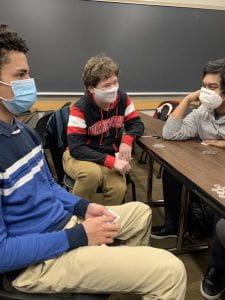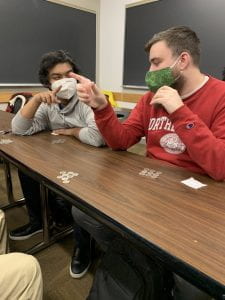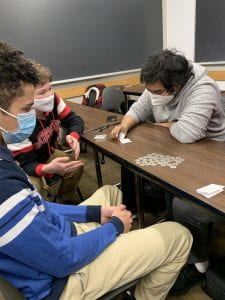Required Materials:
-Paper
-Money
Set-Up:
1. Tear paper up into rectangles. The number of rectangles should be at least double the number of players.
2. On half of the rectangles, write the words “success” or “failure.” Fold these rectangles in half so that the word inside is not visible.
3. On the remaining half of the rectangles, write either gun, knife, or nothing. The number of each type of weapon is up to the group playing, but it is recommended to not have more than one gun and knife. Fold these rectangles in half so the word inside is not visible. Mark the outside of the rectangles in some way to designate that they are weapon cards.
Playing the Game:
1. To begin, have all players draw from the success/failure rectangles. This determines how their job in the robbery was performed. A “success” means there were no issues, and a “failure” means that they failed to adequately perform part of their job. Nonetheless, the robbery was pulled off successfully, and there are no extenuating circumstances as a result of their success or failure. Players are allowed to discuss their success or failure, and they do not need to show their card to corroborate their claim to success or failure.
2. Players are then introduced to the money. The amount of money and where it came from are not significant. If players choose, they can have one player empty the contents of their wallet, they can pool the money they have with them, or do anything they want to obtain the money for this game. The money is then placed in the center of the table.
3. Players now draw weapon cards. The gun card allows a player to shoot someone at the table, eliminating them from the game. The knife card allows a player to stab the person sitting next to them, eliminating them from the game. To attack with a weapon, all a player has to do is say “I shoot/stab [player name].” After the card has been introduced and every player is aware of the weapon, attacks with that weapon must succeed on a coin flip. When the coin is flipped, the player calls heads or tails. If the player is correct, the attack succeeds and the targeted player is eliminated. If the player is wrong then the attack fails and the weapon is taken by the first player who call for it. For example, Player A has a gun. He tells everyone at the table that he has the gun. Now, every attack with the gun must succeed on a coin flip. If Player A fails a coin flip Player B says “I take the gun,” then Player B has the gun and all of their attacks are also subject to the coin flip. Had Player A not disclosed that he had a gun, then his first attack with the gun would have automatically succeeded, but every subsequent attack would have been subject to the coin flip. If a player with a weapon is eliminated, then any player but the one who eliminated them may call for their weapon. If the weapon card has nothing on it, then that player has no weapon. If a player is shot or stabbed, they are eliminated from the game and cannot engage in negotiations.
4. Once weapon cards are distributed, players now negotiate for money. The player with the most amount of money at the end of negotiations gets to keep his money, while the rest is redistributed back to where it came from. Negotiations end when all non-eliminated players are in agreement that the negotiations should end.
Artist Statement:
My major initial inspiration for this game came from a realization I had relating to guns in games. When players are given a gun, they are given agency over a situation. In most games with guns, nearly all problems can be solved by shooting the gun, and using the gun tends to be the best, if not only, way to resolve a conflict. Therefore, I wanted to create a game that focused on this core aspect to weapons in games by placing it in a semi-realistic environment. My first major inspiration was Mechanic is the Message by Brenda Romero, as that set of games is almost always an inspiration for me. Making players think about what game mechanics are trying to get them to do is what I find to be most interesting about game design, and the goal of this game was to get players to think about what having the gun did to their position in the negotiation. My second major inspiration was 16 Tons by Eric Zimmerman. After my first iteration of the project ended in peaceful negotiation with no mention of the gun, I wanted to find a way to make players more driven to win. The way 16 Tons made players pay other players to move their pieces with one player being able to consolidate power and win by making the most money made me realize that having real money in play was the best way for me to get players invested in trying to win. While the initial version of the game used quarters, I had requested for my money back at the end of the game. In my second iteration onwards, I continued to use the same quarters, but allowed the player who had the most quarters to keep them while the rest was up to me. This resulted in the violence and power imbalance that I had intended. However, the weapon was not used as a bargaining piece like I had anticipated. Instead, the weapon was used as a means of countering perceived threats. If one player suspected another of being armed, then they would attack, but they would not attack without that fear. When only one player had a gun in the first iteration, I believe that the lack of another threat in part discouraged the player from attacking, which led to the introduction of the knife.![]()
![]()
![]()
![]()
![]()
![]()
![]()
![]()




